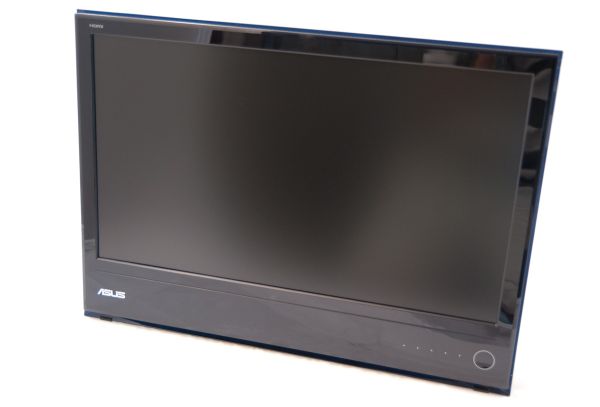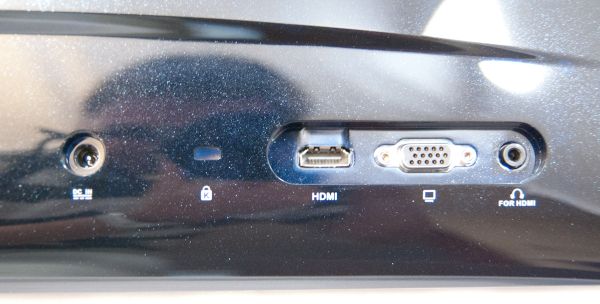ASUS MS238H Review - Slim and Affordable
by Brian Klug on December 24, 2010 1:47 AM ESTIntroduction
So I have a confession to make. The past few months I've been incredibly preoccupied with smartphones, so much so that the ASUS MS238H has been sitting on my desk for a very long time. The data's been largely taken, the display calibrated, but for whatever reason the review has endlessly been on my back burner - I'm sorry ASUS. The upside of this situation, however, is that I've spent a long time using the ASUS MS238 and feel like I know it inside and out, and it's a slim value performer.
Let's start with the specifications. The MS238H is a 23-inch LED-backlit, TN-panel packing display with an extremely slim profile, and even slimmer budget price tag. We're used to primarily covering the high-end side of the market with IPS displays, which the MS238H definitely isn't, but that isn't to say this segment isn't worth taking a look at. The MS238H is also of the 1080P, (and thus 16:9 aspect ratio) variety, a rather disturbing trend that's all but eliminated the 1920x1200, 16:10 market. The specs are what they are, and you can find them in the table below:
| ASUS MS238H - Specifications | |||
| Property | Quoted Specification | ||
| Video Inputs | HDMI, D-Sub (DVI-D through HDMI connector) | ||
| Audio Output | 3.5mm Mini-jack for HDMI Audio | ||
| Panel Type | TN with LED Backlight | ||
| Pixel Pitch | 0.265 mm | ||
| Colors | 16.7 Million (24 BPP) | ||
| Brightness | 250 nits | ||
| Contrast Ratio | 1,000:1, or 100,000:1 (dynamic) | ||
| Response Time | 2ms (g2g) | ||
| Viewable Size | 23" (54.8 cm) diagonal | ||
| Resolution | 1920x1080 (1080P) | ||
| Viewing Angle | 170 degrees horizontal, 160 degrees vertical | ||
| Power Consumption (operation) | <33 watts typical | ||
| Power Consumption (standby) | <1 watt typical | ||
| Screen Treatment | Matte | ||
| Height-Adjustable | No | ||
| Tilt | Yes: 10 degrees - 20 degrees | ||
| Pivot | No | ||
| Swivel | No | ||
| VESA Wall Mounting | No | ||
| Dimensions w/ Base (WxHxD) | 21.9" (556 mm) x 15.9" (403.8 mm) x 5.9" (150.9 mm) | ||
| Weight w/o Stand | 8.4 lbs (3.8 kg) | ||
| Additional Features | 16.5mm thickness, kensington lock | ||
| Limited Warranty | 3 years - repair or replacement | ||
| Accessories | DVI-D to HDMI cable, VGA D-Sub cable, External Power Supply | ||
| Price | MS238H MSRP: $229.99, Amazon: $169.99 | ||
It should be pretty obvious that this display is really oriented at budget-conscious shoppers, or gamers looking for a display small and light enough to augment a notebook or portable LAN party rig. In fact, after carrying the thing to and from rooms to photograph many a time (as inevitably happens with all other displays up for review), that's really what I'm left thinking the MS238H is most suited for. It's light, it's thin, and has a headphone jack for HDMI audio, which makes it suited for periodically connecting up to a console or two.
Inputs are the only real concern on the MS238H - the two options are HDMI or D-SUB for VGA. It'd be nice to see two HDMI ports, or even HDMI and DVI-D, instead of D-SUB. What the MS238H does have going for it is that WLED backlighting, being a power-sipper, and again thin profile.












38 Comments
View All Comments
CharonPDX - Friday, December 24, 2010 - link
Is this what you are looking for?http://www.amazon.com/Male-3-5mm-Stereo-Female-Y-C...
Brian Klug - Saturday, December 25, 2010 - link
Wow, this is actually exactly what I've always wanted. I've got a million RCA->female 3.5mm stereo jacks with female-female connectors on them for when I use my consoles with my FP241W displays. This is awesome! Our commenters rock! Thanks!-Brian
jmunjr - Friday, December 24, 2010 - link
16:9 is absolutely absurd for a computer monitor... I don't know where this trend came from but my guess is the LCD makers realized they could make more profits this way and did some nifty marketing to dupe the morons in the world into thinking it was actually a better format for computing...In protest I have modified a dozen or so of my popular websites by reducing their widths to require even more vertical space.
bhopfner - Friday, December 24, 2010 - link
It's totally true! A widescreen monitor is 20% smaller than the same monitor at 4:3. So of course the LCD industry went with that format. They must save millions. Sure a movie looks great and some games take advantage of the format but for general computing it doesn't help. I want my 20% extra screen real estate!sprockkets - Friday, December 24, 2010 - link
This is dumb. My web browser fits just fine here, and compared to my old 1280x1024 monitor resolution on a 17" monitor, it isn't losing any pixels.This is just another stupid made up issue.
How about I can't use my cable box with a 1920x1200 box without some distortion happening without correction? Ever thought about why they went to 1920x1080? Really missed those 80 pixels on a 1280x800 vs. 1280x720 either?
dertechie - Friday, December 24, 2010 - link
If a 23" monitor barely gains vertically on a 17" monitor, that's not a good thing.You can't use your cable box with a 1920x1200. That's an indictment of the cable box or a monitor designer that neglected to include a 1:1 or preserve aspect ratio mode, not an indictment of the aspect ratio.
We have thought about why they went to 16:9. They can get 11% more panels from a sheet of mother glass (and that's not even counting being able to find more efficient ways to cut it, it may be more). HDTV popularized it, they sell better, and economy of scale compounds that. I actually like seeing 1080p on screens below 24", it's a step forward there.
For media, 1080p is great. Where I don't like 1080p is when I see it in the areas I used to see 1920x1200. 24"-28" monitors used to be mainly 1920x1200. Now, they're mainly 1080p and you have to actually look to find a 16:10 one. It feels like we've regressed instead of going forward. For those of us doing vertically oriented work (like programming), those 120 pixels actually do matter. Nice monitors let you turn the screen, but cheap monitors (and especially cheap TN monitors) don't allow that.
Fritzr - Monday, December 27, 2010 - link
Your cable box should work just fine with a 1920x1200 display. You should see a black band above and below the TV picture though. What you cannot do on a 1920x1080 display is use 1920x1200 wallpaper (a standard size) without distorting it with the 'stretch to fit' display setting.Those blsck bands are NOT a failure of your cable box. It is called letterboxing. The black bands represent the unused portion of the display. If you watch SD broadcasts without reformatting, you will see the same banding on the sides as the picture is not wide enough to fill the screen.
Many HD TVs have an automatic adjustment that stretches the picture to fit the screen. This results in distorted video when viewing 16:9 content on a 4:3 screen and vice versa.
Personally I will accept the penalty imposed by a 16:10 aspect ratio where I am forced to see more of the web page than an HDTV can display.
I would like to get one of the higher resolution screens also. You should avoid those like the plague though...A 3840x2400 cinema class monitor would display your TV screen as a tiny box in the center of the display ... at least until you enable 'stretch to fit display' anywho.
Really scary though is the next generation UltraHiDef TV standard that has been demonstrated in Japan 7680x4320 (16:9) and tbe WHUXGA monitor standard at 7680x4800 (16:10) Those would be nice for big screen displays :)
MobiusStrip - Saturday, January 1, 2011 - link
You won't see this in the U.S. Our asinine "advanced" TV "standard" still allows interlacing and a non-integer frame rate, caps the bitrate at 19 megabits per second, and did not require sets to have updatable firmware. Nor does it define what "HD" means. How many ways can you fail?Then again, we're talking about the successor to the governing body that came up with 29.97 FPS in the first place.
mike8675309 - Thursday, December 30, 2010 - link
People just don't get it, and it is a flaw due to the shift in technology from analog monitors to digital monitors. Their expectations are just so much lower because the common use case simply doesn't demand the vertical resolution.Back in the day where dot pitch and image masks everyone understood what was better, and what was worse. These days they see 24" vs 17" and assume it's better, when in fact it can often be worse and at best, only minimally better.
Sure, movies work at these low vertical resolutions. So do web pages, for the most part. But for software developers and many other technology professionals these low vertical resolutions completely bite and are a tremendous step backward from the reasonably priced performance levels achievable with CRT's in the early 90's.
Sepidoel - Friday, December 24, 2010 - link
Very unfortunate, in my country it's sold way pricier than Amazon (about 340 USD). In regards of 23" LCD, perhaps you may compare it with AOC iF23 - an IPS LED LCD with very affordable price (about 270 USD in my place). I bought one for my sister and I say this is great monitor for the price. I'd like to write an article for Anandtech, but I just simply don't know how to bring up the benchmark numbers.Amazon URL for the 22" one: http://www.amazon.com/22IN-LCD-1920X1080-30000-Pia...